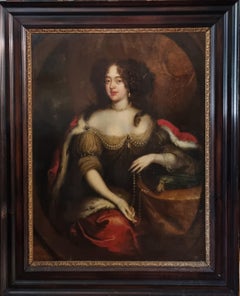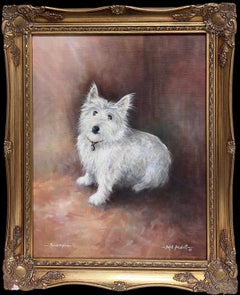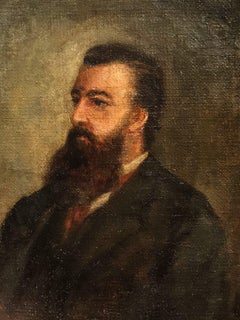School House Antiques Portrait Paintings
to
1
Overall Width
to
Overall Height
to
1
1
1
1
1
1
1
1
1
1
17th Century Oil Painting Portrait Of Catherine Of Braganza Circle of Peter Lely
Located in Hoddesdon, GB
Catherine of Braganza (1638–1705), Circle of Sir Peter Lely (1618–1680)
Queen consort of England, Scotland, and Ireland, married to King Charles...
Category
17th Century English School Portrait Paintings
Materials
Oil
Related Items
Portrait of Scruffy White West Highland Terrier Dog Signed English Oil Painting
Located in Cirencester, Gloucestershire
'Scampi'
Portrait of a characterful White West Highland Terrier Dog
British School, signed and dated
signed oil on canvas, framed
framed: 22 x 17.5 inches
canvas : 18 x 14 inches
Pro...
Category
Late 20th Century English School Animal Paintings
Materials
Oil
Portrait of Thomas Cooper Gotch, 19th Century Oil Painting
Located in London, GB
Oil on canvas on board
Image size: 7 x 5¼ inches (18 x 13.5 cm)
Framed
This portrait of Thomas Gotch is by his lifelong friend and confidante, Jane Ross, whom he met at Heatherley’s...
Category
1880s English School Portrait Paintings
Materials
Canvas, Oil
18th century portrait of the German Flautist and composer Johann Joachim Quantz
By Arthur Devis
Located in Bath, Somerset
Portrait of Johann Quantz (1697-1773), flautist and composer, wearing a blue velvet coat, waistcoat and breeches, standing in a garden landscape with ...
Category
18th Century English School Portrait Paintings
Materials
Canvas, Oil
$14,874 Sale Price
20% Off
H 24.41 in W 19.1 in
Hare coursing outside a country house with hounds Oil British 18th Century
Located in London, GB
Thomas Burford (British, c. 1710-1779)
Hare coursing outside a country house
Oil on canvas
Property of a gentleman
From the collection of Peter Roe
Dimensions:
(Frame) 12.5 in. (H)...
Category
18th Century English School Animal Paintings
Materials
Oil
$7,575
H 12.5 in W 16.5 in D 2 in
Portrait of a Lady possibly Frances Thynne, Lady Worsley 1673-1750 Oil on canvas
By Charles Jervas
Located in St. Albans, GB
Charles Jervas
Possibly Frances Thynne, Lady Worsley 1673-1750
Oil on Canvas
Picture Size: 50 x 40"
Outside Frame Size: 58 x 48"
1675 – 1739
Charles Jervas, who was born in Clonli...
Category
Early 1700s English School Portrait Paintings
Materials
Oil
$41,649 Sale Price
20% Off
H 58 in W 48 in D 3 in
Antique Late 19th Century English Oil on Canvas Painting Female Portrait 1900
Located in Portland, OR
Antique English oil on canvas portrait painting, circa 1900. A very handsome Impressionist portrait of a youthful lady in Edwardian dress. Oil on canvas, signed to the upper left "F ...
Category
Early 1900s English School Portrait Paintings
Materials
Canvas, Oil
$1,900
H 33.25 in W 29.5 in D 2 in
Saddled bay hunter horse Oil on canvas British 1863
Located in London, GB
Benjamin Herring Snr (British, 1830-1871)
Saddled bay hunter
1863
Oil on canvas
With old Christie's stencil verso
Property of a gentleman
From the collection of Peter Roe
Dimension...
Category
18th Century English School Animal Paintings
Materials
Oil
$8,263
H 19 in W 23.5 in D 2 in
Grey stallion held by groom in Duke of Grosvenor’s colours British 18C
Located in London, GB
Richard Roper (British, c. 1730-c. 1775)
Grey stallion held by groom in the Duke of
Grosvenor’s colours
Oil on canvas
Old chalk inscription '22 Mar 74' verso
Property of a gentleman...
Category
18th Century English School Animal Paintings
Materials
Oil
$13,084
H 26 in W 28 in D 2 in
Mid-18th-Century English School, Portrait Of A Girl With A Posy
Located in Cheltenham, GB
This exceedingly charming mid-18th-century English oil painting depicts a girl wearing a red gown with a train over a white petticoat. She’s holding a posy or nosegay.
Evidently once commissioned for an English country house, the identity of this young lady remains a mystery. Her gown appears to be inspired by the popular ‘robe à la française...
Category
1740s English School Portrait Paintings
Materials
Oil, Canvas
Large British Sporting Art Country House Oil Painting Portrait of Hunting Hound
Located in Cirencester, Gloucestershire
Portrait of a Foxhound
Andrew Alexander ( Contemporary British)
signed and dated 1985
oil on board, framed
framed: 30 x 35 inches
board: 24 x 29 inches
Provenance: private collec...
Category
1980s English School Animal Paintings
Materials
Oil
A portrait of an English terrier dog standing in a walled garden, signed.l
By John Emms
Located in Bath, Somerset
A terrier named Joe standing in an English country house walled garden, painted by the eminent animal painter John Emms (1844-1912) in the late 19th cent...
Category
1890s English School Animal Paintings
Materials
Oil, Canvas
English 18th century portrait of a water spaniel dog standing in a landscape
By George Stubbs
Located in Bath, Somerset
Circle of George Stubbs (1724-1806). English 18th century portrait of a water spaniel standing in a wooded landscape.
This charming painting is a wonderful example of the style of English dog painting made popular by artists such as George Stubbs and other sporting artists working in England in the 18th century who painted the dogs and horses of the aristocracy and wealthier classes. It follows in the ancient tradition of celebrating and commemorating our faithful canine companions through portraiture.
Oil on canvas in a giltwood frame
Provenance: Private collection, Somerset
George Stubbs (1724-1806) was classified in his lifetime as a sporting painter, and as such was excluded from full membership of the Royal Academy. He is best remembered for his paintings of horses and his conversation pieces. Having studied anatomy, Stubbs's pictures of horses are among the most accurate ever painted.
Stubbs was born in Liverpool, the son of a leather worker...
Category
18th Century English School Animal Paintings
Materials
Canvas, Oil
$15,892 Sale Price
20% Off
H 27.56 in W 31.11 in


